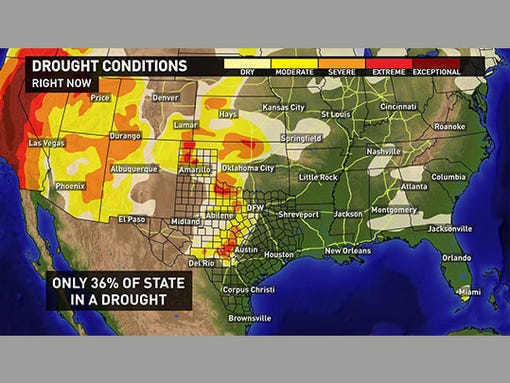Good news in a May 15 report filed by WFAA8, the local ABC TV station in northern Texas (Dallas-Fort Worth metroplex). That part of the supersize state has been hit with enough rain to buoy it out of the worst of a long drought: "In just a month, our lakes that have been empty for years are now filling up again -- just in time for summer."
 |
Yet on the same day as the WFAA report the Statesman, an Austin newspaper, was opining on how the same rains were affecting central Texas:
|
Is the Central Texas drought really over? Not so much
But wait, you say. It’s been raining for weeks, and the Palmer Drought Index shows that Texas, once bathed in red for extreme drought, is now mostly white or yellow.
That drought map we are so intimately familiar with measures soil moisture, not regional water supply. So while the foliage is lush and the ground is currently saturated, Austin’s water reservoirs are still exceptionally parched. We are still in what’s known as a hydrological drought.
“Yes, we’ve gotten rain and yes we are thankful for it,” said John Hofmann, vice president of water for the Lower Colorado River Authority. “But we are not out of this drought — not by a long stretch.”
For those who are uninitiated to the vagaries of Austin’s weather patterns, this recent spate of daily downpours is unlike any stretch they’ve seen in Central Texas.
But washed out roads, swirling waters, flooded greenbelts and tornado watches are just a much of Central Texas in May as blistering 100-degree days, which are still certain to arrive in a few weeks. After all, this is still Texas.
May is typically one of the wettest months of the year in Central Texas. This May has generated enough moisture to move most of the state out its yearslong extreme drought. While the news is welcome, it’s hardly cause to reorder St. Augustine sod for your dead lawn or to start taking 30-minute showers again.
Rain in Texas is like real estate: location, location, location. While the rain gauges in the city are full, far less has fallen on the Highland Lakes — the primary source of Austin’s drinking water. Parts of the state may be receiving 10 inches at a time, but in the Llano watershed, which feeds the lakes, the amounts have been less than an inch, Hofmann said.
That’s not to say that there isn’t some good news. Lake Travis has risen nearly eight feet this year and more than two feet this month to 631 feet above sea level, bringing the lake to it to highest point in more than two years. Additional rains and watershed drainage has the LCRA forecasting at least another foot increase over the next week. Those few feet means that a few more boat ramps can reopen — including the one at Pace Bend Park — and lakeside businesses can contemplate the possibility of a somewhat busier Memorial Day weekend.
The bad news is that Lake Travis is still nearly 40 feet below average, while levels on Lake Buchanan have barely budged. Our water reserves at both are at less than 40 percent of their capacity. Don’t believe it? Just check out the white limestone ring that still stretches out from the water of Lake Travis to the grass line.
In the short term, that poses a safety hazard for boaters who haven’t been on the lake. In the long term, we all still need to fret about our water usage and take seriously the call to conserve.
Enjoy your lush green yards now. We’re still a long way away from getting out of Level 2 water restrictions. And based on Texas’ boom and bust cycles of rains, we would suggest forgetting about twice weekly watering forever. Water conservation should remain a permanent state of mind.
We agree with Hofmann, who told us: “Don’t let your guard down … our status is unchanged.”
Why? Because of regional watering restrictions triggered by the levels of lakes Travis and Buchannan. By that measure, the two lakes would need to capture more than another 120,000 acre feet of water to enable the city of Austin to even consider loosening the current restrictions — and we’d have to maintain those levels for at least four months.
The heavy rains from the first week of May, according to the most recent report available from the city, only generated about 7,222 additional acre-feet of water for the two lakes, which means it would take either a tropical storm or a long rainy season directly over the Hill Country to refill those reservoirs. And there is always another drought lurking around the corner — or a flash flood, which comes with its own problems.
The irony of Austin weather is that it can flood even in the midst of drought. So while our neighbors to north and west look for more rain, residents to our south and east are increasingly ready for a break. While the deluges so far have produced relatively minor flooding, an ill-timed or ill-positioned storm burst could prove destructive and deadly.
That is both the blessing and curse of weather in Central Texas. Wait five minutes and it will change.
[END OP-ED]
No comments:
Post a Comment